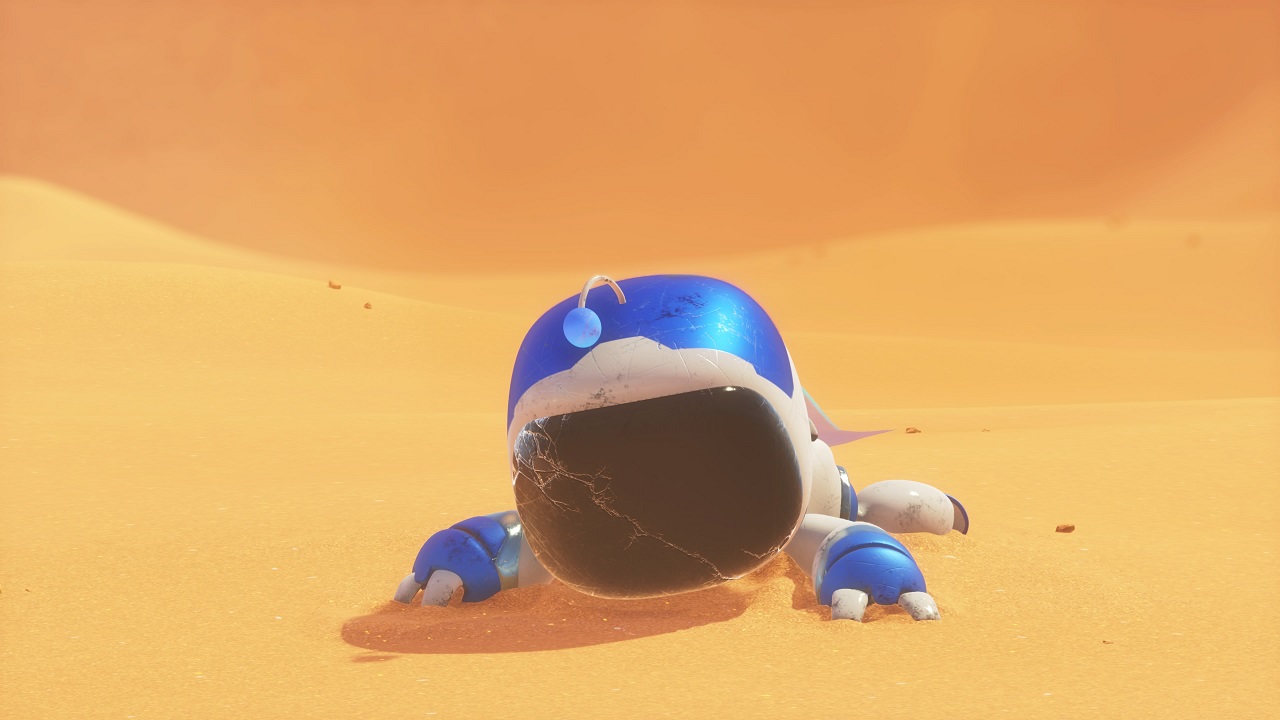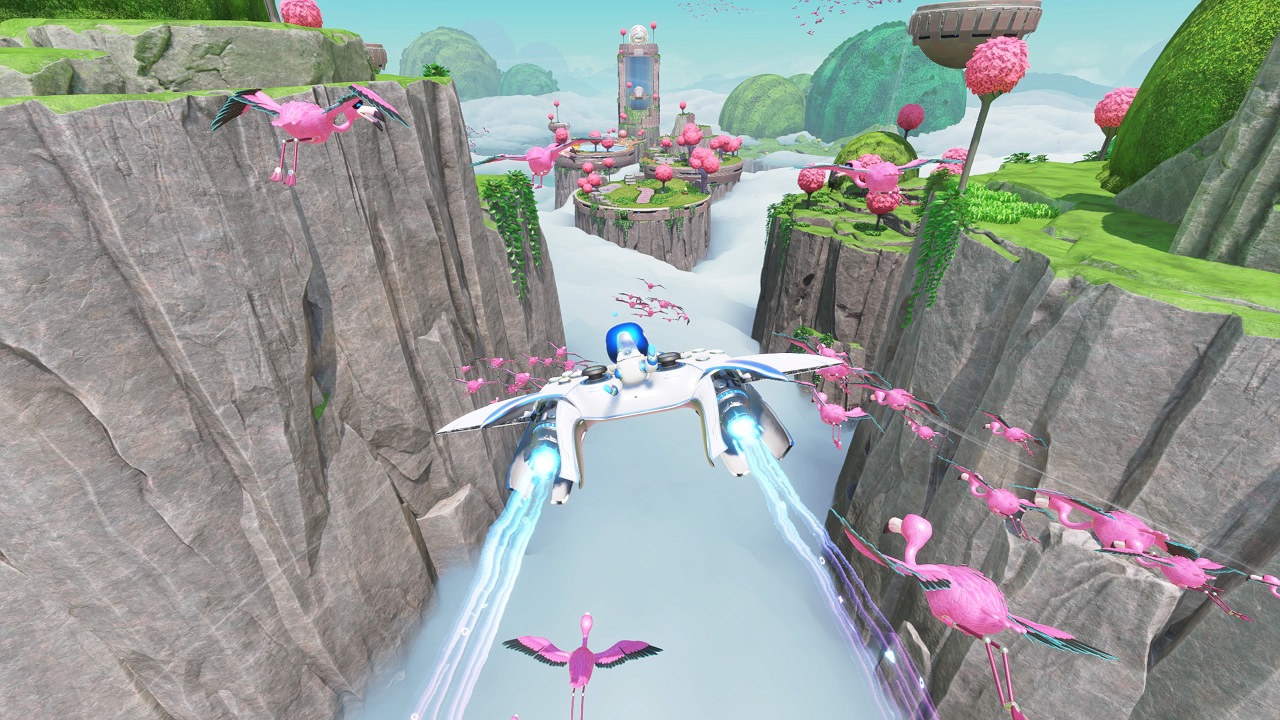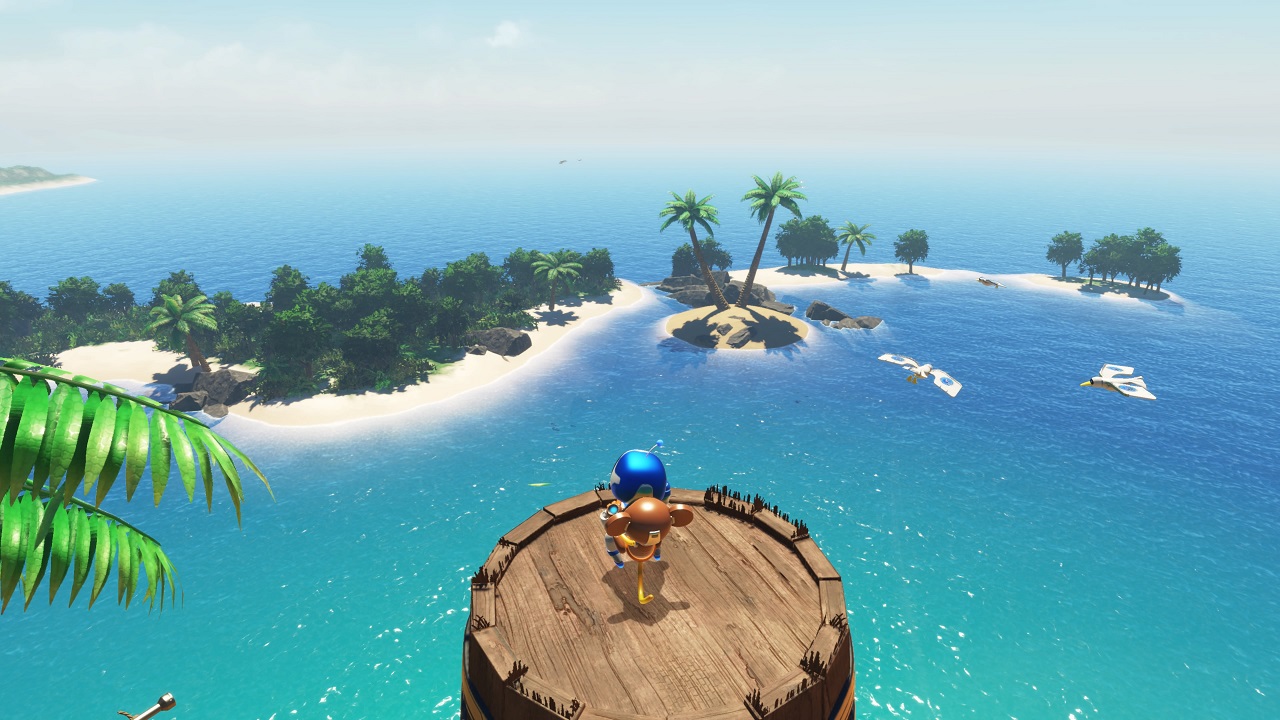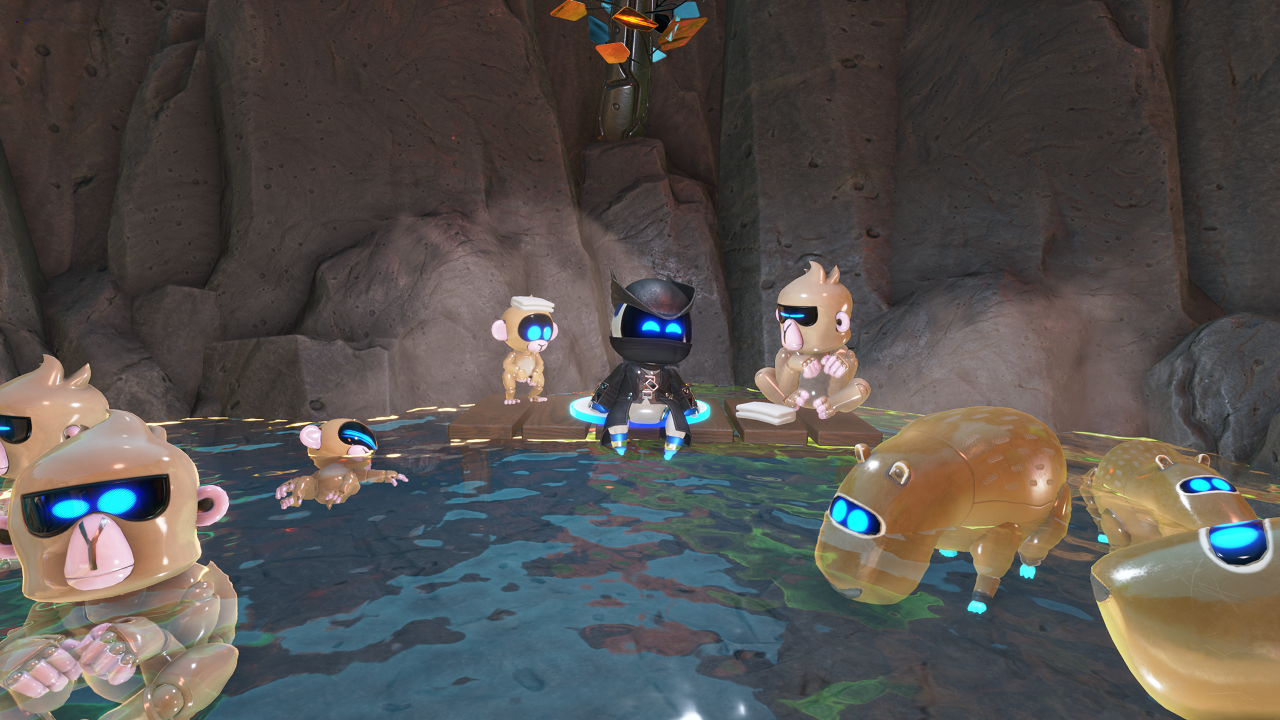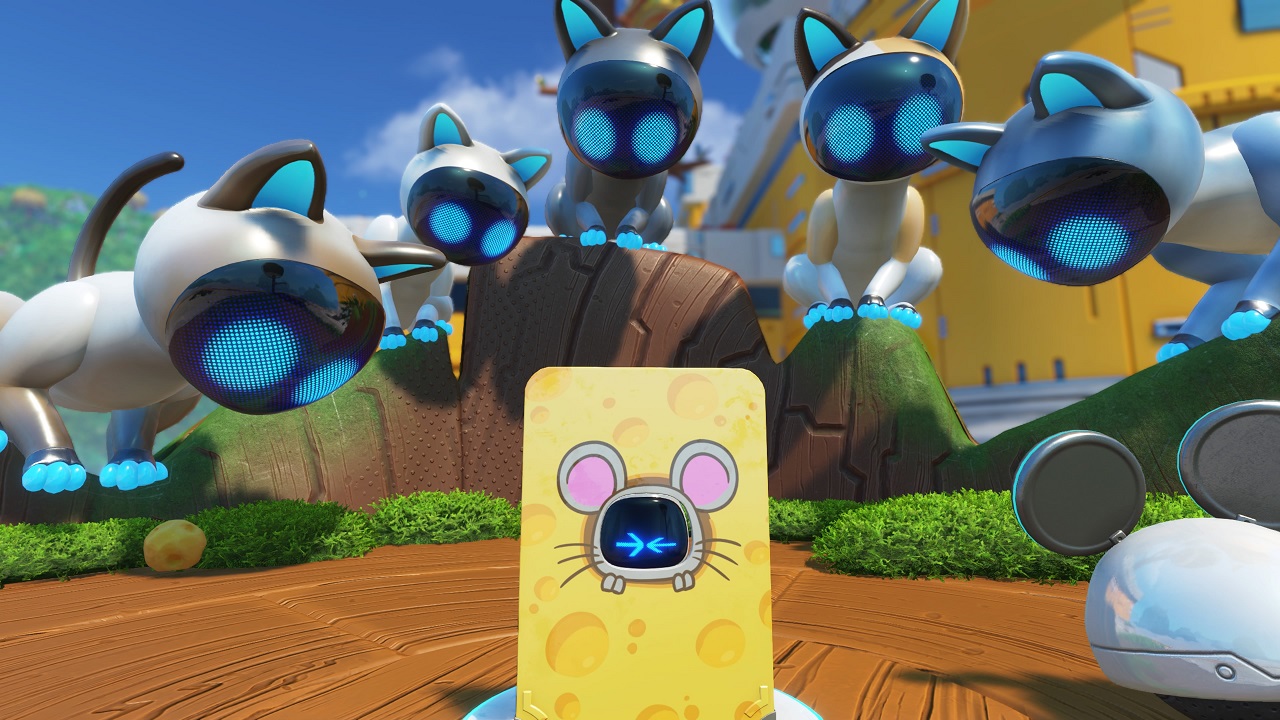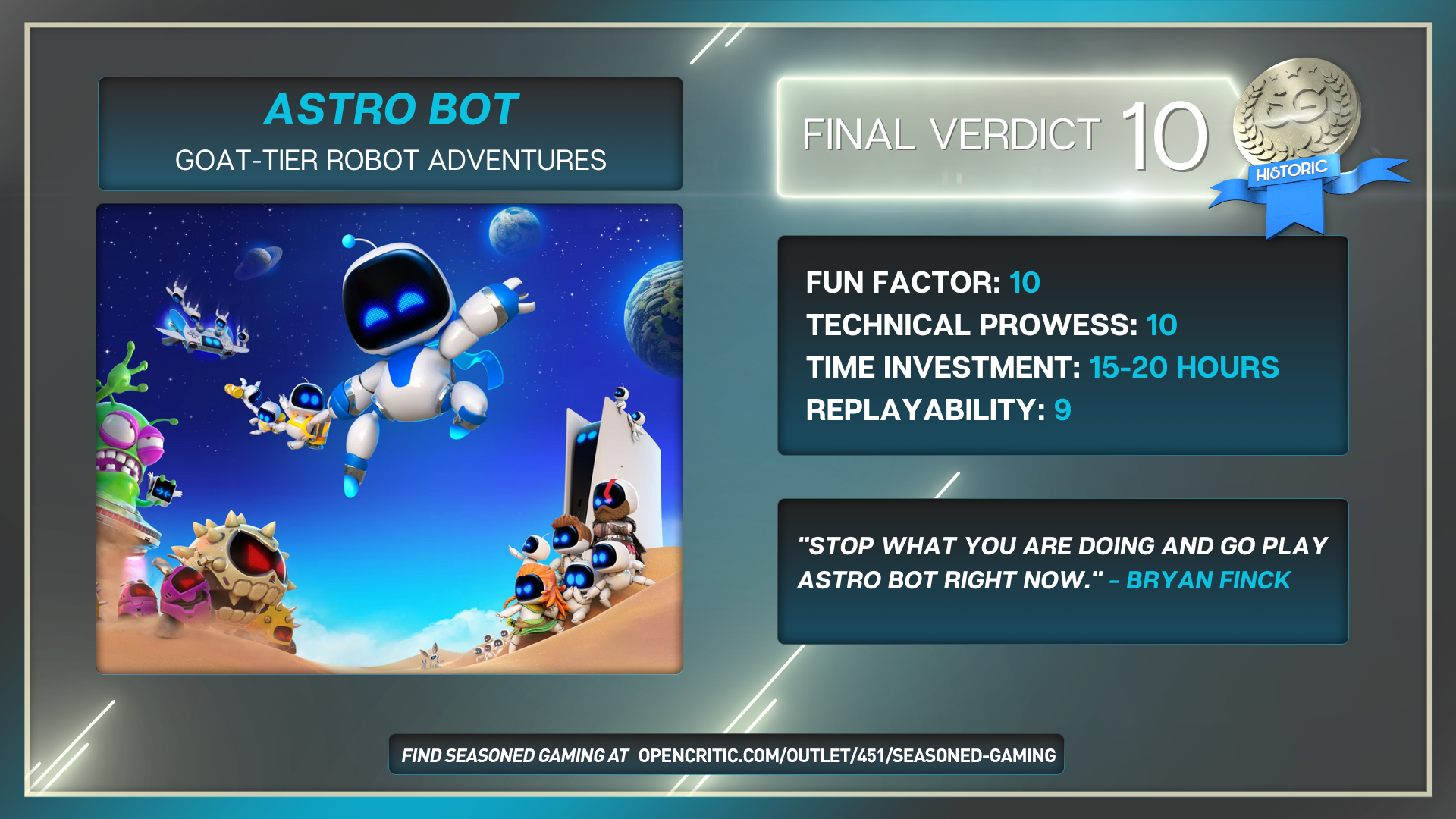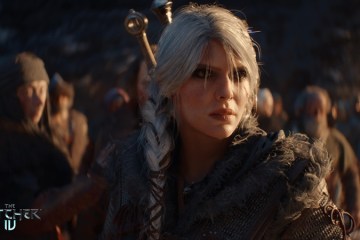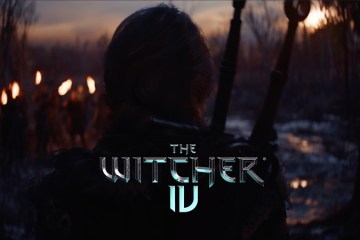Nostalgia is a double-edged sword. By definition, it carries a sadness and melancholy for good times gone by, never to be reclaimed. Luckily, nostalgia in the video game world often means reliving joyful hours spent with classic games and platforms, memories that still echo in the present as the evolution of those past days informs the creations that we enjoy today.
When the PlayStation 5 debuted in 2020, it came with the rarest of modern-day game genres: a free pack-in title. Astro’s Playroom was a shout-out to the legacy of the PlayStation brand and a promise of things to come, with gorgeous visuals, lightning-fast gameplay, and integration of the DualSense controller’s features that are still among the best on the console, even four years later.
Now, PlayStation fans have received another helping of that nostalgia in the form of Astro Bot, a full-fledged version of what Astro’s Playroom promised at the console’s launch. If the pack-in game was a love letter to PlayStation fans and the console’s history, Astro Bot is a book of finely crafted love poems in your favorite romance language. Or, to put it another way, fellow Seasoned Gaming contributor and lifelong gamer Steve Esposito says, “It’s genuine fun. Really brings me back to the days where I’d wake up on Saturday mornings, eat some sugary breakfast, and play games while my parents stayed in bed.”
If that’s not the definition of nostalgia that developers and publishers aim for, then I don’t know what is.
Let’s get one final thing out of the way before we start: Astro Bot is great… really great. It does so many things right, while avoiding practically all missteps, that it easily qualifies as one of the greatest games ever created in its genre. One of the central tenets of my experience with the game was the joy of discovery and a sense of wonder at each new level, so this review will be as close to spoiler-free as possible. I want you to enjoy the same sense of delight I had through every step of the journey.
Adventures in Space
Story is certainly not the focus of Astro Bot, but it sets the stage for all the goodness to follow, so it bears mentioning. Cruising through space in his PS5 spaceship, the titular character and his buddies from Astro’s Playroom are set upon by a cackling green alien in a UFO. He attacks the ship and sends it plummeting toward a desert planet far below. The ship is damaged, and its critical parts are scattered throughout the universe. Astro must head out to reclaim the components and put the ship back in working order.
At this point, you gain control of Astro, and you can wander about the site of your rapid, unplanned descent, seeing what there is to be found. There isn’t much you can do yet, but that will certainly change as this becomes the hub world for your adventures. It is one of the best parts of the game, so we will revisit it later.
When you’re ready, you’ll launch into space on your DualSense speeder (appropriately called the DualSpeeder) and be presented with 5 different galaxies, with just one, shaped unmistakeably like a gorilla, active for you to start exploring. As you enter the galaxy, you’ll see it is actually a collection of planets that represent the game’s levels. Each galaxy has 4-6 levels, and as you complete each one, a few more become active for you to tackle next. Each level has a set number of Astro’s friends and surprise guests to be rescued from the minions of the aforementioned Big Bad Alien. You’ll also collect puzzle pieces that show up back on your hub planet to unlock other features and a few other surprise goodies that only appear on certain planets.
Once you’ve conquered all the levels in a galaxy, you can proceed to take on the boss of that system, but you must have rescued a certain number of bots in order to “unlock” the fight. I didn’t have a problem with that particular requirement because it ensures you will see at least a significant portion of the content Team Asobi has lovingly placed at your fingertips. And my goodness, what wonders they have created.
Every level is a feast for the eyes, with bright colors, multiple levels, and secrets everywhere, with both friends and enemies around every corner. Things are moving no matter where you look; robo-animals hurry to and fro, bad guys wait for your arrival to turn and attack in groups, platforms move from place to place, rain occasionally starts falling (prompting Astro to pop out an umbrella from his helmet, of course), and so much more. I could (and often did) just stand and stare into the distance at the gorgeous vistas and small details alike because there is just so much to see and do. The developer did a wonderful job making each level distinct, with different environmental features and weather effects, and often a few massive landmarks spread around the landscape.
I personally covet verticality in game levels, regardless of the genre, and Astro Bot is a masterclass in how to do it correctly. You can enjoy the height of the architecture from afar, but, when you get close, you get the feeling of being a very small part of the world as you scale to the top where more adventure awaits. One of my favorite levels plays with this in a delightful way, taking an idea that is admittedly not new but executing it perfectly.
As I said in the intro, discovering these levels for yourself is one of the game’s great joys, so I don’t want to spoil anything for you. But I’m too excited about a few levels to avoid mentioning them completely. The Halloween/ghost level is the most atmospheric in the entire game and has the coolest use of a special power. And the levels that are themed after some of Sony’s biggest franchises are simply sublime, full stop. Take my advice: go slowly through each level, just walk around and take it all in; you’ll be glad you did. One last piece of advice – punch everything; it’s how Astro interacts with the world, and you’ll be rewarded for it more often than not.
Jump, Punch, It’s All in the Mechanics
As much as I love the level design, it would all be just pretty window-dressing if the gameplay wasn’t up to snuff. Happily, the moment-to-moment action and variety of what you’re doing is just as good as the playspaces themselves. The game builds on the basic principles introduced in Playroom, so you’ll be doing a lot of jumping, punching, and running in true platformer style. If you hold down the jump button, you’ll coast along for a few seconds with your rocket boots, which is important for movement as well as being an offensive weapon in its own right, allowing you to destroy most enemies. The triggers do a lot of heavy lifting when it comes to special abilities and powers, of which there are many.
To gain those powers, you’ll be joined by several companions that are typically animal-like in form and worn as a backpack, not all that different from how Ratchet and Clank get around together. Astro will also receive a few costumes that convey special abilities, and he can even transform into a different version of himself on occasion to utilize some level-specific game mechanic. These all work incredibly well as variations on the typical gameplay, and they are largely the reason the action never gets stale across the 80 or so levels that Sony has advertised as making up the full game. Even to the last few levels in the final galaxy, small new features and fun movements were introduced that help you mine the full expanse of the game’s secrets.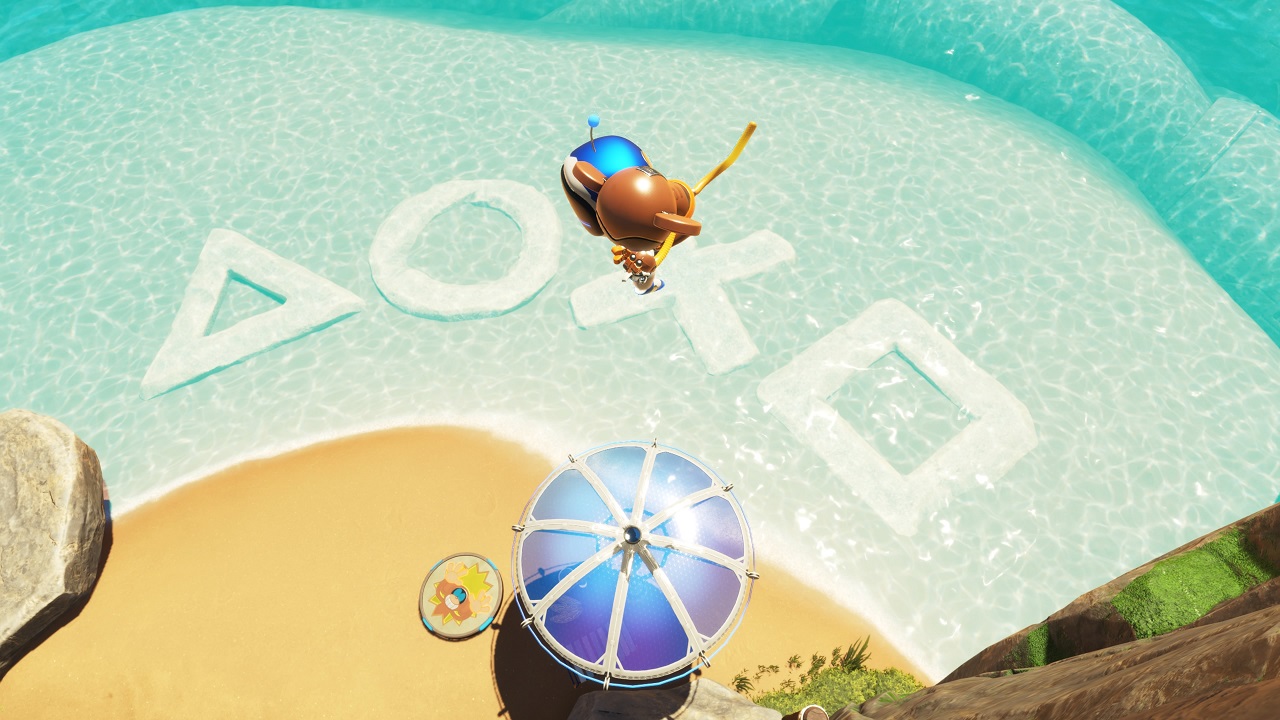
All this offensive firepower would be pretty boring without enemies to use it on, and here Astro Bot delivers yet again. The cast of bad guys is delightful, with a variety of more than 70 different types for Astro to punch, pull, and launch throughout his adventure. Combat is not truly difficult over the run of play, but there are a few enemy types that will give you a bit more trouble than others. The bosses are roughly the same level of difficulty on a grander scale, so all the combat is slightly challenging but leans more toward enjoyability.
Where you will truly find the game’s peak difficulty is with the four sets of challenge levels, corresponding to the famous PlayStation symbols. These appear after defeating every level in a galaxy, and there are four levels each decorated with the eponymous Square, Circle, Triangle, and Cross. These levels, while short, offer a significant challenge due to the timing and dexterity needed to navigate the environmental obstacles. The levels are extremely fair, so failure or success is entirely in the hands of the player, giving the “just one more run” feeling that only the best games can inspire.
Even with all the different mechanics, the gameplay is rock solid. We’ve all played janky games where things just don’t feel right; maybe the timing is off or your character just doesn’t have the proper weight or feeling of connectedness to the environment. There are so many ways a platformer can go wrong, but none of that happens in Astro Bot; it all works and feels sublime, from the first jump to the last punch you throw. For a game that relies on precise jumping and landing, due in part to the verticality of the level design, a lack of connectedness to your on-screen movements could have been the kiss of death, but Team Asobi really has created near-perfection here.
Look, Listen, and Hold on to Your DualSense
Even if Astro Bot had PS2-level aesthetics, I would still recommend it without a second’s hesitation. Thankfully, this game looks and sounds like it belongs on the PS5 squarely in the next generation. Despite what I’m sure was the immense temptation to release a PS4 version of the game to that console’s 100+ million user base, we should all be glad that this is a current-gen-only game. Certainly, the graphics and sound are best served by the power of the PS5, but the DualSense features are so central to the experience that a PS4 version would have felt like a much different and lesser game.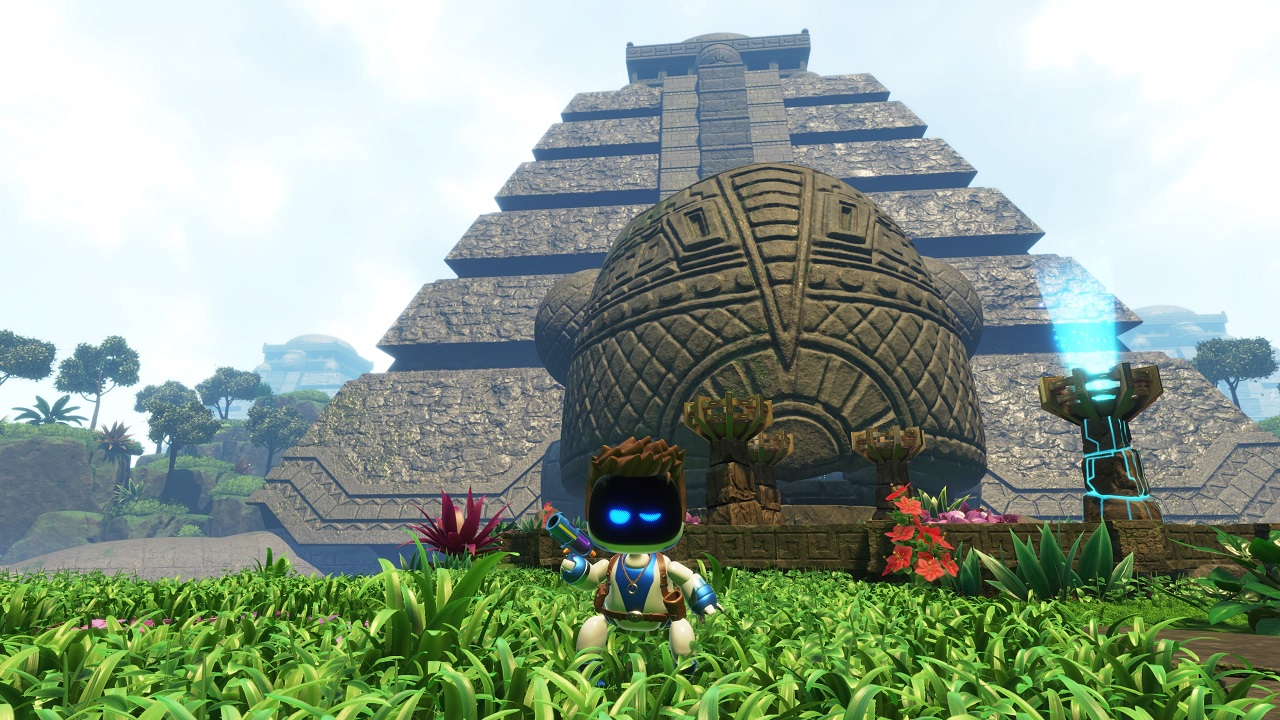
Astro’s Playroom showed the world what Team Asobi was capable of, and the sequel turns everything up to 11. The animations are flawlessly smooth, I never noticed a hint of slowdown or frame drop, and the draw distance is immense, leading to some of my favorite vistas in any game to date. From massive environments, bosses, and set pieces to the smallest graphical flourishes (watch what happens when you scare the birds), the game is as much a treat to watch as it is to play.
Beyond just having another visually stunning game in its catalog, I think this was an extremely important game for Sony to help them shed their reputation, deserved or not, of being the home of the so-called post-apocalyptic, Sad-Dad simulator genre. The days of Crash and Spyro are long past, and while the ultra-realistic, ultra-violent cinematic adventures sell consoles, Nintendo continues to prove that other types of games, specifically those cute platformers very much in the same ballpark as Astro Bot, can move large quantities of hardware, too.
Do yourself a favor and play the game with the best headphones you can get your hands on – I promise you won’t regret it. From the smallest sonic detail of walking across a metal surface to the roars of anger from various enemies, the soundscape is dynamic and varied, start to finish. That excellent work extends to the music as well, as the soundtrack is adorable and catchy without being obtrusive. It fades into the background when the action gets heavy, never overpowering the sound effects, but is there to greet you when you’ve made it through a tough patch.
Once I finished the game, the soundtrack still sounded fresh and enjoyable, not an easy feat for my particular tastes. These are the types of games I’ll often play on mute because the sounds don’t typically impact the overall experience, but here they are an absolutely indispensable part of the whole package. Some tracks play an outsized role in particular levels, and my favorite involves a large tree on a garden-themed planet. You’ll know it when you hear it; the voice work and lyrics are truly amazing.
The third part of the aesthetic triumvirate, what truly ties the whole experience together, is the groundbreaking haptic feedback features of the DualSense controller. Through that remarkable technology, what you see and hear becomes what you actually feel happening in your hands. As you tread across glass panels, they start to crack and crumble. You see it happening, you hear the tinkle of falling glass, and you feel the sensation, like tiny shocks of electricity course through the handles of the controller.
There are dozens of instances like this throughout the game, and while it is almost always superbly implemented, it did give rise to basically my lone problem with the game. The adaptive triggers are used heavily here to simulate various powerful forces, like the engines of your speeder and the launch of a rocket that comes with one of your special abilities. The triggers/feedbacks are too boisterous in these moments, shaking the entire controller and making a huge racket, and it grows tiresome very quickly. You cannot adjust them in-game, and turning it down or off in the system settings affects the other parts of the game where these features are essential. It is a minor quibble to be sure, but seeing as this particular mechanic is used heavily in the second half of the game, it was very noticeable.
All the Small Things
I can’t possibly finish this review without making mention of the delightful set of extra goodies that Team Asobi has included for the completionists and those who really want to dive into Astro’s world. Every level in the game has robots who need rescuing, as we’ve mentioned, but that is in no way the end of the collectibles on offer. Those levels also contain a healthy number of coins scattered everywhere along the main and hidden paths.
I loved how some spots held coins that only revealed themselves after you reached that particular area or defeated a group of enemies, just another way the game encourages you to explore the depth and breadth of each area. These coins are also found in crates scattered throughout the level, so give those a smack, and the coins will come pouring out. It reminds me of the loot in the Ratchet & Clank games, where you’re rewarded for bashing everything with your Omniwrench. I said it before, and I’ll say it again – punch everything.
You’ll also be looking for puzzle pieces on each level, some that are in plain sight and some that you’ll have to find through a brief puzzle or in a hidden space. Each one of these fits into a blank canvas back on the hub world, and when the puzzle fills in, you get a brand new feature to enjoy. You’ll quickly get the Gatcha Lab, which functions the same way it did in Playroom, where you spend all those glorious coins, 100 at a time, to get a random prize ball from the machine and open it to reveal all kinds of goodies (I won’t ruin the surprise, remember).
Eventually, you will open up a customization lab for your DualSpeeder to provide it with various snazzy paint jobs, as well as a costume warehouse for Astro to put on outfits you collect from the Gatcha machine. These are both delightful extras, but the best of them all is the Safari Garden, where you can find and take pictures with all of the animal denizens you run across in your travels. Think of it like a small version of Pokemon Snap, and you have the idea; it’s not hard to guess that the kiddos will be enamored with this particular bit of additional content.
Speaking of the hub planet, it is rife with things to do and places to explore in its own right. There are multiple areas within the crash site that house their own bots to be rescued and puzzle pieces to be found. And guess where all your bot friends go once you’ve rescued them from their precarious plights? You got it – the hub planet turns into a living trophy case, where every bot hangs out, waiting to help you in various tasks that require different numbers of helpers to accomplish.
They might be making a bot chain to swing across a chasm or a wall to climb up to reach a towering height, but they are all cleverly implemented and a joy to behold. There’s nothing quite like crawling over tiny robot versions of Solid Snake and Dante to grab some extra coins… it’s as absurd and delightful as it sounds, trust me. Not only are they useful, but you can see each of them hanging out in the hub world. Instead of a staid trophy room presentation, all your bot friends are here for you to see and interact with. Just make sure you punch every one of them for a delightful character-specific surprise.
A few quality-of-life features that I absolutely loved deserve their own mention. In collect-a-thon games like this, finding what you missed can sometimes devolve the experience into an unpleasant slog, akin to the pixel-hunting of old-school adventure games. Once again, the developer gets it right with their methods of tracking everything down. Each level clearly displays how many bots, puzzle pieces, and other goodies it has to offer, and you can tell approximately where in the level each one should be by its position in the list.
And if you simply cannot find a few of the goodies, they go even one step further to help you out. At the beginning of each level, when you play through it again after your initial foray, you can spend 200 coins to unlock a bird companion with a radar dish on its head. The bird follows you through the level and gives both visual and auditory alerts when you are close to a secret. Use those to hone in on the missing goodies, and you’re golden – it’s a brilliant bit of kit that keeps the focus on fun and discovery, and I hope it makes its way into other games of this type.
Conclusion
As a PlayStation lifer, lucky enough to own every mainline console Sony has ever created, I feel like this game was made for me. Not for gamers like me, but specifically for me. I see that as a critical point because what Team Asobi has accomplished here is to create an almost RPG-like experience in how it will be different for each person who plays the game. Not that the game itself will play out differently, but each person will feel something different owing to the all-important nostalgia factor. Few will have experienced every Sony game referenced here, but the personality built into each character will evoke something unique and special for each person who has played those particular games. I actually yelled out loud with joy when I found the post-apocalyptic survivors from my favorite franchise, and I suspect I won’t be alone in those kinds of reactions.
I could go on and on about this game, and I’m sure I’ve missed scads of details here and there, but, again, I want you to discover as much of this as possible for yourself. Go play the game, or watch someone play it and enjoy their reactions. Whatever you do, just experience Astro Bot in some manner. It is one of the best PlayStation games and platformers ever created and one of the happiest times I’ve ever had with a controller in my hand. During increasingly dark times in the gaming industry, Astro Bot is a desperately needed ray of sunshine, so get out there and bask in it.
You can find Seasoned Gaming’s review policy here.

